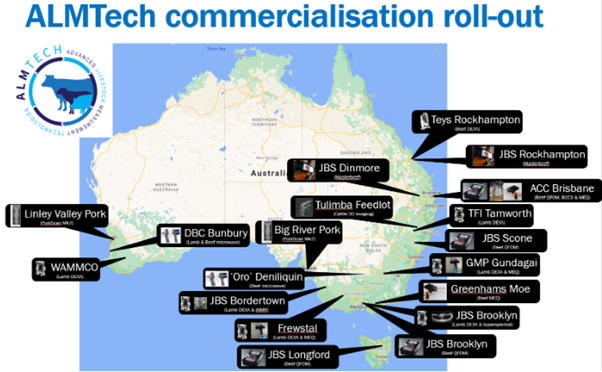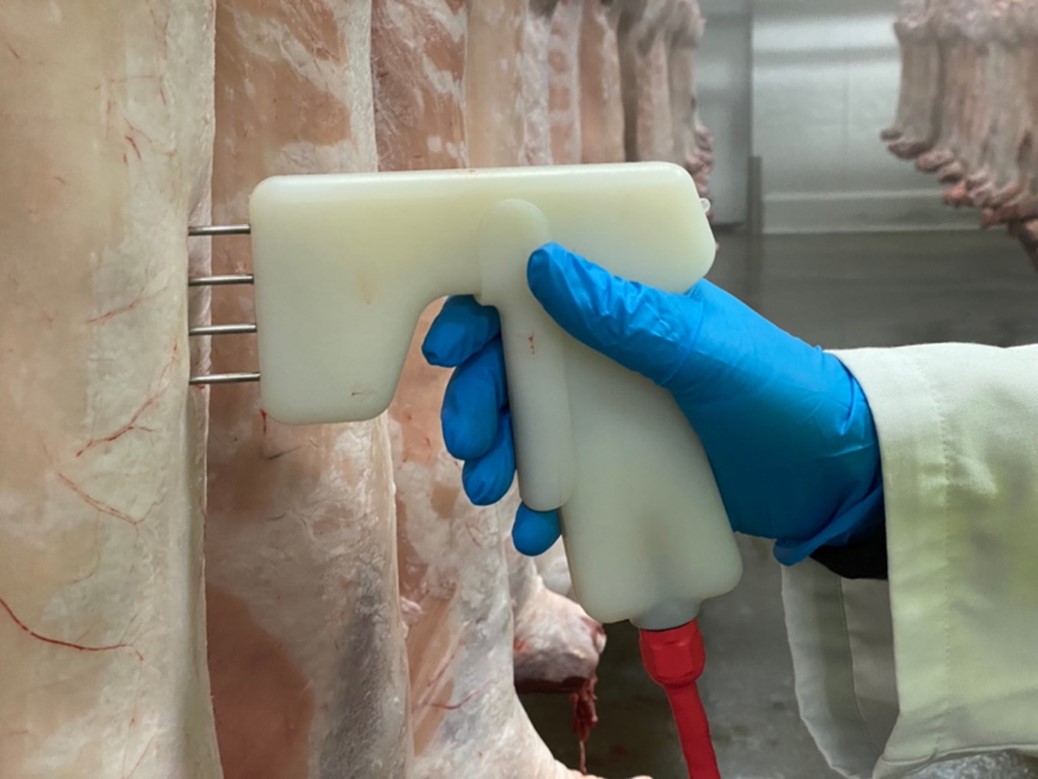Developing and commercialising advanced measurement technologies and feedback systems into globally competitive Australian meat value chains (“ALMTech II”)
Summary

ALMTech II focused on enhancing the Australian beef, lamb and pork industries’ ability to respond to market demands and capture value-chain price differentials, via advanced objective measurements of red meat quality and quantity. In the Australian beef industry these price differentials represent an opportunity to capture an estimated $130 million per year from producers supplying cattle that better meet company and consumer requirements, with similar opportunities in lamb and pork. Advanced measurements and feedback will enhance the transparency of trading across the livestock value chain. By 2040, it is estimated that ALMTech (I & II) will have generated a net present value (NPV) of $858 million net benefits to the beef, lamb, and pork industries in Australia.
ALMTech II supported the development and commercialisation of technologies to provide beef, lamb and pork producers with advanced measurements of two key attributes that influence the value of livestock: lean meat yield (LMY) percentage and eating quality (EQ). Within abattoirs, these technologies needed to be adaptable to pre- or post-chill deployment, robust in an abattoir environment, and capable of operating at the processing fastest chain speeds. On-farm, objective measurement technology costs became more crucial given that farms generally cannot achieve the same “economy of scale” through-put available to abattoirs.
ALMTech II’s ambition was to realise significant productivity and profitability improvements for primary producers, via the following objectives:
- Provide beef, lamb and pork producers with access to more accurate descriptions of the key attributes that influence the value of their livestock: LMY% and EQ; and compliance to market specifications, delivered via advanced measurement technologies, in synergy with abattoir automation where appropriate;
- Enhance feedback systems to provide producers with new information that enables improved decisions on breeding and compliance to market specifications;
- Deliver new tools and data to processors that can be used by producers to improve the rate of genetic gain and processing efficiency, while optimising their capacity to allocate product to the most valuable market end-point, thereby increasing the wealth of the value chain participants;
- Capitalise on the co-operation of industry stakeholders to maximise effective decision making, reduce risk and optimise profit for all partners;
- Develop an early-stage prototype of objective measurement equipment for offal condemnation; and
- Develop and improve these technologies and systems to increase competitiveness and profitability in the Australian meat value chain.

Notable achievements across the life of ALMTech include:
- Supporting the installation, calibration, and monitoring of commercial dual energy x-ray absorptiometry (DEXA) systems in six lamb abattoirs and one beef abattoir, enabling the development and launch of the world-first value-based pricing grid for lamb by Gundagai Meat Processors.
- Introducing three new traits for the lamb and beef industries to trade upon, each of which has been endorsed by the Australian Meat Industry Language and Standards Committee (AMILSC) and are now included in the AUS-MEAT language; including proposed error tolerances, accreditation processes and auditing systems:
- Lamb carcase lean, fat, and bone% based on computed tomography as the reference standard;
- Lamb intramuscular fat percentage (IMF%); and
- Beef intramuscular fat percentage (IMF%).
- Introducing conversion equations for transforming beef IMF% into the equivalent visual marbling scores used by Meat Standards Australia (MSA) and AUS-MEAT, which have been endorsed by AMILSC, pending final acceptance by the MSA Pathways committee.
- Introducing a new set of accreditation standards for camera-based technologies to predict rib-eye traits such as Fat Colour, Meat Colour, Rib Fat Depth, Eye Muscle Area, and MSA and AUS-MEAT marble scores, including specification of error tolerances, the accreditation process, and the auditing system, which have been endorsed by AMILSC.
- Undertaking industry evaluation of the first commercial prototype of a hand-held microwave fat-depth scanner for lamb and beef in live animals and carcases, at a commercial beef feedlot, and Dardanup Butchering Company and WAMMCO, respectively.
- Installing and evaluating hardware for 3D imaging of live cattle at the Tullimba feedlot.
- Supporting the commercialisation and accreditation of the Frontmatec Q-FOM beef loin-eye grading camera, the first commercial deployment at a commercial abattoir. Three additional abattoirs have commenced pre-commercial trials.
- Supporting the development and evaluation of novel and emerging devices employing different technologies for estimating EQ (especially IMF%), including the SOMA Optics S-7090 device, an Optical Coherence Tomography probe, the Trinamix portable Near Infra-Red device, and a nuclear magnetic resonance (NMR) scanner for both beef and sheep carcase IMF% measurement.
- Investigating the potential of the Rapiscan dual-view Multi-Energy X-ray Absorptiometer (MEXA) augmented with hyperspectral imaging for rapid, non-invasive, in-line detection and assessment of offal defects. This technology is showing promise for other propositions, such as grass- versus grain- meat authentication, though these propositions require further validation.
- Investigating the value of measuring eye muscle dimensions in lamb carcases and collating MSA data from lambs processed in the Meat & Livestock Australia (MLA) Resource Flock projects, pending full genetic analysis of these data.
- Supporting the development and refinement of a Beef Value Calculator (BVC), a Lamb Value Calculator (LVC) and Carcase Optimisation Tool (COT) to enable processors to define carcase value more accurately and optimise market-specific carcase use, based upon predicted cut weights before fabrication.
- Liaising with supply chains to integrate device outputs into commercial decision-making systems and to create new and enhanced genetic tools to select for LMY% and EQ.
As detailed in the ALMTech Economic Evaluation Exit Report, summing each annual benefit out to 2040 as reflected in the assumed adoption profile, accounting for estimated user costs and discounting back to 2023, the estimated NPV for net benefits for the beef industry scenarios (prior to accounting for R&D costs) is $123 million, for the sheep meat industry scenarios is $538 million, and for the pig meat industry scenarios is $197 million.
Aggregating these measures across the three industries gives an estimated NPV of net benefits of $858 million, accounting for ongoing user costs but prior to accounting for R&D investment costs.
Adjusting MLA and APL R&D costs to real 2020 values and summing across the three industries generates a discounted cost aggregate of $128 million.
Therefore, the overall OM theme of work has resulted in a discounted net benefit of $730 million with an estimated benefit to cost ratio (BCR) of 6.7:1.
Program Executive
- 1: Undertake project initiation, project planning and management
- 2: Undertake communication and extension activities
- 3: Undertake industry liaison and value estimation
- 4: Undertake monitoring and evaluation, including general management of technology calibration
Program 1: Develop lean meat yield (LMY) measurement technologies, both on farm and in the abattoir
- 1: Develop live measurement of lean meat yield (LMY)
- 2: Develop carcase measurement of LMY (direct)
- 3: Develop carcase measurement of LMY (indirect)
Program 2: Develop eating quality (EQ) measurement technologies in the abattoir
- 1: Commercialise two technologies for grading eating quality in beef carcases and two technologies for grading eating quality in lamb carcases
- 2: Develop and validate new eating quality (EQ) technologies
Program 3: Align these technologies with automation
- 1: Develop a commercially deployable automated solution for measuring offal condemnation
Program 4: Enhance producer feedback systems and genetic tools using new measurements from these technologies
- 1: Develop data flow to industry information delivery systems
- 2: Develop data flow to industry genetic evaluation systems
Program 5: Align data into decision systems to enhance profitability
- 1: Enhance carcase value tools
- 2: Enhance data decision tools
- 3: Enhance supply chain engagement.
In the immediate future, industry will require continued support to adopt and make best use of the new measurement technologies and for ongoing auditing and calibration testing.


